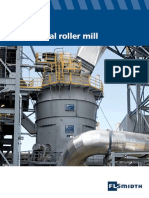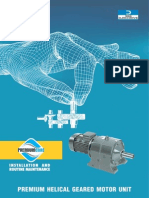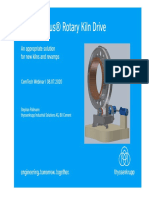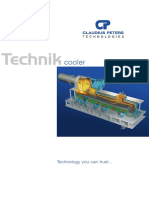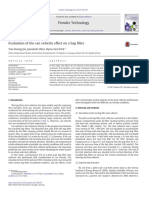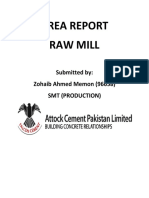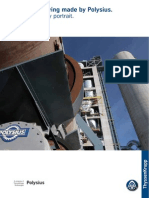Ball Mill Inspection
Ball Mill Inspection
Uploaded by
mahantmtechCopyright:
Available Formats
Ball Mill Inspection
Ball Mill Inspection
Uploaded by
mahantmtechCopyright
Available Formats
Share this document
Did you find this document useful?
Is this content inappropriate?
Copyright:
Available Formats
Ball Mill Inspection
Ball Mill Inspection
Uploaded by
mahantmtechCopyright:
Available Formats
www.thecementgrindingoffice.
com
www.thecementgrindingoffice.com Page 1
BALL MILL INSPECTION PROCEDURE
Introduction
This document is intended to help the staff of the cement plants.
On a process point of view, a mill inspection is only representative if the grinding mill circuit is in a steady working
condition with a representative cement product.
If this condition is fulfilled, the whole installation must be stopped in crash-stop (it means all the equipments
must stop at the same moment).
It is better to enter first into the first compartment in order to follow the flowpath of the material from the
beginning of the grinding process.
Generally, people enter in a manhole. From time to time, when the mill diameter is larger, it is possible to enter
from the mill inlet.
This procedure was performed for a 2 compartments mill.
For other configurations of mills, a simple adjustment is necessary.
For outside staff, it is also necessary to check the kind of internals and the length of the chambers.
What we need:
Now, let's go inside the mill (for the turkish bath...)
www.thecementgrindingoffice.com
www.thecementgrindingoffice.com Page 2
First chamber
Action
Data-Measurement
Reason
1 Mill inlet:
- Check if the inlet is clean and not
blocked
To allow a good ventilation of the mill.
- Check the mill material feeder
To allow a good progression of the feed.
- Check if there are screws and their
condition
Height of screw
Number of screws
To avoid accumulation of material and
balls.
- If there is water injection system,
check its
Visual appreciation
Water injection in chamber 1 can be
necessary in case of very hot clinker.
2 Feed end liners:
- Check the condition and the wear of
these liners
Thickness
To maintain the mill shell protected.
- Check if there are broken liners
Number
3 Volume load or filling degree
- The measurement must be achieved
in 3 points on the mill-axis (inlet,
middle of compartment and
compartment outlet). The best
procedure is probably to measure
the height from the ball charge to
the linings
3 points
(mesure height H)
To maintain the production (tons/hour) of
the mill because the volume load is directly
linked to the mill absorbed power and the
mill efficiency.
- Other method: count the number of
visible lining plates (less reliable
At least 3 points
If it is the only way to measure the volume
load.
www.thecementgrindingoffice.com
www.thecementgrindingoffice.com Page 3
method)
4 Linings
- Check the condition and the wear of
the linings (Lining practically worn-
out on the picture)
Thickness
Lifter height
To maintain the lining efficiency (don't
forget that the function of the 1st chamber
is TO CRUSH).
- Check if there are broken plates
Number
To maintain the mill shell protected.
- Check if there is coating
Evaluate if it is hard
to remove, measure
the thickness
This phenomenon can happen, especially in
the case of raw mills.
Causes inefficient grinding, low throughput
and high energy consumption.
5 Ball charge
- Check the ball charge: the principle
is to evaluate visually the proportion
of big balls (90mm) and small balls
(60mm)
Better with
experienced
persons
To maintain the crushing efficiency of the
1
st
compartment.
- Measure the biggest and the
smallest ball diameter
Minimum
Maximum
To determine the next ball make up
composition or the substitution of the ball
charge.
- Check if there are broken balls
Visual estimation
To avoid blockage of the intermediate
diaphragm.
To analyse the balls quality with the
supplier.
- Check if there is coating
Evaluate if it is hard
to remove
Causes inefficient grinding, low throughput
and high energy consumption.
www.thecementgrindingoffice.com
www.thecementgrindingoffice.com Page 4
6 Material level
- Check the material level at mill inlet
Not enough material may be due to high air
velocity.
Result is the loss of this part of chamber.
- Check the material level (too high
you don't see the balls, good if you
see the top of the balls, not enough
material if you don't see it)
Make a design
Visual estimation
Measure if too high
Not enough material can cause breakage of
balls.
Too much material results in a drop of
efficiency.
- Check specially at the intermediate
diaphragm
Remove the balls
Not enough material may cause excessive
wear of the grid plates of the diaphragm.
7 Sampling of the first chamber
- Take 3 or 4 samples (inlet, 1 or 2
intermediate samples, at the
diaphragm)
2-3kg/sample
In order to know the efficiency of the first
compartment.
- Ideally for each sample, take
materiel in three points as shown on
drawing here below
Mill-axis point is the
best if only 1 point
This is more representative.
- Remove the balls at the sampling
point
Depth of 20-30 cm
To allow the sampling with the collector.
This is more representative.
- Don't reject the unground particles
from the sample
Especially at the
diaphragm
It is important to know the percentage of
uncrushed particles, especially at the
diaphragm.
- Drop a ball on unground grains (put
these grains on the top of a ball)
near the diaphragm
Height 30-40cm
To have an idea of the hardness of these
grains.
www.thecementgrindingoffice.com
www.thecementgrindingoffice.com Page 5
8 Intermediate diaphragm
- Check the general aspect of the
diaphragm
Visual
- Check the condition and the wear of
the plates and the grid plates
Visual and thickness
To insure the protection of the diaphragm
frame.
- Check the width of the slots and if
there are blocked by unground
particles or scraps
Maximum width
Minimum width
% of area blocked
To insure that the slots of the intermediate
diaphragm are smaller than the slots of the
outlet diaphragm.
- Check the condition of the central
screen
Visual
To prevent the passage of balls from one
compartment to the other.
- Check other specific features like
control systems
To determine if these features have the
good settings.
Second chamber
Action
Data-Measurement
Reason
1
Intermediate diaphragm
- Check the condition and the wear of
the back plates
Visual and thickness To insure the protection of the diaphragm
frame.
www.thecementgrindingoffice.com
www.thecementgrindingoffice.com Page 6
2 Volume load or filling degree
- The measurement must be achieved
in 4 points on the mill-axis (inlet, first
third of compartment, second third
and compartment outlet). The best
procedure is probably to measure
the height from the ball charge to
the linings
4 points
(mesure height H)
To maintain the production (tons/hour) of
the mill because the volume load is directly
linked to the mill absorbed power and the
mill efficiency.
- Other method: count the number of
visible lining plates (less reliable
method)
At least 4 points
If it is the only way to measure the volume
load.
3 Linings
- Check the condition and the wear of
the linings
To maintain the lining efficiency (don't
forget that the function of the 2nd
chamber is TO GRIND).
- Check if there are broken plates
Number
To maintain the mill shell protected
- Check if there is coating on the
linings
Evaluate the impor-
tance of the problem
Evaluate if it is hard
to remove, measure
the thickness
This phenomenon can happen, especially in
the case of open circuit.
Causes inefficient grinding, low throughput
and high energy consumption.
www.thecementgrindingoffice.com
www.thecementgrindingoffice.com Page 7
4 Ball charge and classification
- Check the ball charge: the principle
is to evaluate visually the proportion
of big balls (60mm) and small balls
(17-15mm)
Better with
experienced
persons
To respect the initial ball charge
recommendation.
To maintain the efficiency of the 2nd
compartment.
- Measure the biggest and the
smallest ball diameter
Minimum
Maximum
To determine the next ball make up
composition or the substitution of the ball
charge.
- Check if there are broken balls
Visual estimation
To avoid blockage of the outlet diaphragm
slots.
To analyse the balls quality with the
supplier.
- Check if there is coating on the balls
Evaluate the impor-
tance of the problem
Evaluate if it is hard
to remove
Causes inefficient grinding, low throughput
and high energy consumption.
- In case of classifying lining, check the
classification of the balls (perfect,
good, poor or disturbed, mixture of
the balls, reversed classification)
Visual estimation
Sampling of the
charge but takes
time and a lot of
hard work
Bad classification may be due to a bad
lining, excessive coating or presence of
unground particles coming from the first
compartment.
Causes inefficient grinding, low throughput
and high energy consumption.
5 Material level
- Check the material level (too high
you don't see the balls, good if you
see the top of the balls, not enough
material if you don't see it)
Visual estimation
Make a design
Not enough material may be due to high air
velocity.
Result is a higher wear, a drop of efficiency
and lower throughput.
Too much material may cause overfilling, a
drop of efficiency and lower throughput.
www.thecementgrindingoffice.com
www.thecementgrindingoffice.com Page 8
6 Sampling of the second chamber
- Take 6-8 samples (inlet, 4-6
intermediate samples at equal
distance, diaphragm)
500gr to 1kg for each
sample
In order to know the reduction efficiency of
the second compartment.
- Ideally for each sample, take
materiel in three
Mill-axis point is the
best if 1 point
It is more representative.
- Remove the balls and the material at
the sampling point
Depth of 20-30 cm
To collect the material only in surface is not
correct.
- With the shovel, put balls and
material in the sieve which is above
a paper bag. Remove the balls from
the sieve. Put the collected material
in a bag
Don't forget to put possible uncrushed
particles with the material sample!
- Check the presence of uncrushed
particles, especially an accumulation
at mill outlet
Visual estimation
Accumulation causes blockage of the outlet
diaphragm and a drop of efficiency and
throughput.
7 Outlet diaphragm
- Check the general aspect of the
diaphragm
Visual
- Check the condition and the wear of
the plates and the grid plates
Visual and
thickness
To insure the protection of the diaphragm
frame.
www.thecementgrindingoffice.com
www.thecementgrindingoffice.com Page 9
- Check the width of the slots and if
there are blocked by unground
particles or scraps
Maximum width
Minimum width
% of area blocked
To insure that the slots of the outlet
diaphragm are bigger than the slots of the
intermediate diaphragm.
- Check the condition of the central
screen
Visual estimation
To prevent the passage of balls.
- Check the condition of the water
injection system and if it is blocked
by material (nozzle)
Visual inspection
Maybe, it is useful to make a test in order
to see the trajectory of the water jet.
You might also like
- Check List Rotary Packer: Packing Plant General StatusDocument3 pagesCheck List Rotary Packer: Packing Plant General StatusTITUS YUSUF100% (1)
- VP - 10 - Ball Cement Mill Monitoring, Inspection & EvaluationDocument41 pagesVP - 10 - Ball Cement Mill Monitoring, Inspection & Evaluationrecai93% (14)
- 1st Chamber Liner ManualDocument9 pages1st Chamber Liner Manualprediletto100% (1)
- OK Vertical Roller MillDocument8 pagesOK Vertical Roller MillHiresomannavar Mahantesh100% (2)
- Jaypee Cement Project ReportDocument29 pagesJaypee Cement Project ReportPurnendu MishraNo ratings yet
- Loesche Grinding Plants For Coal GasificationDocument45 pagesLoesche Grinding Plants For Coal GasificationMaxim Polevoy100% (1)
- 03 MPT Introduction - Basics of VRM Process - R1Document20 pages03 MPT Introduction - Basics of VRM Process - R1Camilo CamposNo ratings yet
- Qena Hka ReportDocument56 pagesQena Hka ReportMohammed gNo ratings yet
- Blaz Jurko - GEBR. Pfeiffer - MPS Grinding Technology PDFDocument22 pagesBlaz Jurko - GEBR. Pfeiffer - MPS Grinding Technology PDFrpazb100% (1)
- 043 Grinding PDFDocument11 pages043 Grinding PDFbkchoudhury1993No ratings yet
- Atox 45 Raw Mill Critical Interlock SheetDocument6 pagesAtox 45 Raw Mill Critical Interlock SheetValipireddy NagarjunNo ratings yet
- AUMUND Bucket Elevators 180801Document16 pagesAUMUND Bucket Elevators 180801Tino TorehNo ratings yet
- VRM Roller Bearing FailureDocument39 pagesVRM Roller Bearing FailureReda M.SalemNo ratings yet
- Raw Mill InspectionDocument20 pagesRaw Mill InspectionAtiq Ur RehmanNo ratings yet
- Finish Mill Girth Gear Routine InspectionDocument1 pageFinish Mill Girth Gear Routine InspectionErmiyas MistreNo ratings yet
- MAMMUT Single-Shaft Hammer Crusher: HilfsvorrichtungenDocument1 pageMAMMUT Single-Shaft Hammer Crusher: HilfsvorrichtungenpeymanNo ratings yet
- Key PMR's Lead Wire Test Procedure: 1. PurposeDocument10 pagesKey PMR's Lead Wire Test Procedure: 1. PurposeMohammed BNo ratings yet
- Conveying SystemDocument33 pagesConveying SystemYhaneNo ratings yet
- Kiln Installation MatthiasDocument62 pagesKiln Installation Matthiasquỳnh lêNo ratings yet
- Training PODFA: Mechanical Maintenance of Preheater and KilnDocument164 pagesTraining PODFA: Mechanical Maintenance of Preheater and KilnДен Стаднік100% (1)
- Helical Gearbox InstallationDocument8 pagesHelical Gearbox InstallationKUNALJAYNo ratings yet
- ESPDocument15 pagesESPlrpatraNo ratings yet
- Polguide Final PalDocument15 pagesPolguide Final Paldeepak kumarNo ratings yet
- Raw Mill Check ListDocument2 pagesRaw Mill Check Listlaxman JoshiNo ratings yet
- VRM-Roller Seal-Of OCL PlantDocument3 pagesVRM-Roller Seal-Of OCL Plantayaskant751001100% (2)
- Tube MillsDocument44 pagesTube MillsRodrigo AlcainoNo ratings yet
- WNCC-Kiln Overhaul Shutdown Plan 01-07-2020, Rev#00 (Update To 19-7-2020)Document15 pagesWNCC-Kiln Overhaul Shutdown Plan 01-07-2020, Rev#00 (Update To 19-7-2020)Mahmoud HanafyNo ratings yet
- CP Cooler TechnikDocument16 pagesCP Cooler TechnikFarid AhmedNo ratings yet
- Mechanical Kiln InspectionDocument6 pagesMechanical Kiln InspectionMostafa KordyNo ratings yet
- AUMUND Pan Conveyors Fd0a10Document24 pagesAUMUND Pan Conveyors Fd0a10Bruno100% (1)
- 15th NCB Technical PaperDocument10 pages15th NCB Technical PaperSalah RomdaniNo ratings yet
- Can VelocityDocument4 pagesCan VelocityRawatNo ratings yet
- 07 RP-RP in Various ModeDocument43 pages07 RP-RP in Various Modeaff bearNo ratings yet
- Training For Tensioning Hydraulic System MPS MillsDocument69 pagesTraining For Tensioning Hydraulic System MPS MillsImam SampoernoNo ratings yet
- Training Hyd System in Cement IndustriDocument36 pagesTraining Hyd System in Cement IndustriNatsuko KayamaNo ratings yet
- Hot Kiln AlignmentDocument24 pagesHot Kiln AlignmentNael100% (2)
- Area Report Raw Mill: Submitted By: Zohaib Ahmed Memon (96658) SMT (Production)Document7 pagesArea Report Raw Mill: Submitted By: Zohaib Ahmed Memon (96658) SMT (Production)Zohaib AhmedNo ratings yet
- Gap Measurement and Displacement Between The Kiln Shell and Tire (Kiln Tires)Document8 pagesGap Measurement and Displacement Between The Kiln Shell and Tire (Kiln Tires)Javier Gutierrez100% (1)
- Ball Mill Inspection - Chap 1Document6 pagesBall Mill Inspection - Chap 1Min MCLNo ratings yet
- Rotary Vessel Mechanical MaintenanceDocument6 pagesRotary Vessel Mechanical Maintenanceritesh shrivastavNo ratings yet
- Kiln Out LetDocument2 pagesKiln Out LetSamehibrahemNo ratings yet
- Girth Gear Axial Reading After Full WeldingDocument1 pageGirth Gear Axial Reading After Full WeldingAbobakr GaberNo ratings yet
- Kiln Alignment AnalysisDocument36 pagesKiln Alignment AnalysisIINo ratings yet
- 34 MER AuxiliariesDocument37 pages34 MER AuxiliariesCamilo CamposNo ratings yet
- Basics of HydraulicsDocument13 pagesBasics of HydraulicsJames DanielNo ratings yet
- Chap 4 3 PDFDocument28 pagesChap 4 3 PDFtaghdirimNo ratings yet
- Importance of Dedusting Pipe LayoutDocument4 pagesImportance of Dedusting Pipe LayoutManoj ThakurNo ratings yet
- 2nd Chamber Liner ManualDocument5 pages2nd Chamber Liner ManualpredilettoNo ratings yet
- 11.30 DR Stefan Seemann, KHD Humboldt Wedag GMBHDocument15 pages11.30 DR Stefan Seemann, KHD Humboldt Wedag GMBHMohd AliNo ratings yet
- FLS Ok Mill Common Platform WEB PDFDocument12 pagesFLS Ok Mill Common Platform WEB PDFVerananda AriyantoNo ratings yet
- Christian Pfeiffer Foreign Matter TrapDocument1 pageChristian Pfeiffer Foreign Matter TrapMohamedNo ratings yet
- Presep Air Separator VTP enDocument6 pagesPresep Air Separator VTP enBrunoNo ratings yet
- Ball Mill Inspection ProcedureDocument9 pagesBall Mill Inspection ProcedureIrshad HussainNo ratings yet
- CGO-Ball Charges CompositionDocument5 pagesCGO-Ball Charges CompositiontuhintahmidNo ratings yet
- Cement-Separator-Ball-Mill-Optimization 2Document29 pagesCement-Separator-Ball-Mill-Optimization 2La KubaisiNo ratings yet
- Cement Separator & Ball Mill OptimizationDocument29 pagesCement Separator & Ball Mill OptimizationAdelezzat OmranNo ratings yet
- Ball Mill Inspection Procedure PDFDocument4 pagesBall Mill Inspection Procedure PDFYoya AhmedNo ratings yet
- CGO-Ball Charge Samplin1Document12 pagesCGO-Ball Charge Samplin1tuhintahmidNo ratings yet
- Laboratory Report CONSTRACTION MATERIAL PDFDocument19 pagesLaboratory Report CONSTRACTION MATERIAL PDFHASSAN YTQANNo ratings yet
- Grinding Technology of Limestone With Ball MillsDocument16 pagesGrinding Technology of Limestone With Ball MillsanruloNo ratings yet
- Plastic Injection Mold Design for Toolmakers - Volume III: Plastic Injection Mold Design for Toolmakers, #3From EverandPlastic Injection Mold Design for Toolmakers - Volume III: Plastic Injection Mold Design for Toolmakers, #3No ratings yet
- CementDocument37 pagesCementmahantmtechNo ratings yet
- B271M PDFDocument6 pagesB271M PDFmahantmtechNo ratings yet
- HP English PDFDocument12 pagesHP English PDFmahantmtech100% (2)
- A4-P 1.1 enDocument23 pagesA4-P 1.1 enmahantmtech100% (1)
- 1600 GB WEB PDFDocument21 pages1600 GB WEB PDFmahantmtechNo ratings yet
- The GR8 Ms-ExcelDocument222 pagesThe GR8 Ms-ExcelmahantmtechNo ratings yet
- 2012.08 POV S.S. Bagchi S.V. Ghule and R.T. JadhavDocument4 pages2012.08 POV S.S. Bagchi S.V. Ghule and R.T. JadhavmahantmtechNo ratings yet
- The Bond Work Index of Binary and Ternary Mixtures of Ceramic Raw MaterialsDocument5 pagesThe Bond Work Index of Binary and Ternary Mixtures of Ceramic Raw MaterialsmahantmtechNo ratings yet
- Mill ScanDocument6 pagesMill ScanmahantmtechNo ratings yet
- India's Premier Coal Industry EventDocument8 pagesIndia's Premier Coal Industry EventmahantmtechNo ratings yet
- Visual Clips: at MCC - School-ShahabadDocument5 pagesVisual Clips: at MCC - School-ShahabadmahantmtechNo ratings yet
- Questions For Class 1: Chen 733 Coal CombustionDocument6 pagesQuestions For Class 1: Chen 733 Coal CombustionmahantmtechNo ratings yet
- 4 FerreticDocument1 page4 FerreticmahantmtechNo ratings yet
- 2011 Power Wheel GuideDocument16 pages2011 Power Wheel GuidemahantmtechNo ratings yet



